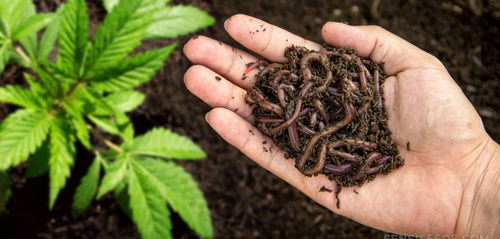#14: The Glass-Eyed Guide to Cannabinoids: Decoding the Mystery of Cannabis
#14: The Glass-Eyed Guide to Cannabinoids: Decoding the Mystery of Cannabis
There was a time when the secrets of cannabis were largely unknown, and the knowledge of its effects and different components was shrouded in mystery. Over the years, cannabis has been subjected to extensive scientific studies that have drastically increased our understanding of the plant. At the core of this research are the various cannabinoids, the active chemicals responsible for cannabis’ effects.

Cannabinoids are produced in the flowers and leaves of cannabis plants, with each plant typically containing dozens of different cannabinoids. There are over 100 different cannabinoids, each with its own unique effects and properties. Tetrahydrocannabinol (THC) and cannabidiol (CBD) are two of the most recognized cannabinoids, but there are many others that are gaining attention for their potential therapeutic effects. Knowing how these cannabinoids interact with each other is key to understanding the effects of cannabis.
In this guide, we’ll explore the different cannabinoids found in cannabis and discuss the potential therapeutic benefits that each one may offer. We'll also provide an overview of the endocannabinoid system, a network of receptors and enzymes that helps regulate many physiological processes in humans. So, let's dive in and unlock the secrets of cannabis!
What are cannabinoids, and why are they important?
Cannabinoids are typically divided into two categories: phytocannabinoids (those produced by plants) and endocannabinoids (those naturally occurring in humans). The therapeutic effects of cannabis are largely attributed to the phytocannabinoids, which interact with the endocannabinoid system to produce a range of health benefits.

The ECS is a regulatory system found in all mammals and is responsible for maintaining balance in the body. It is composed of cannabinoid receptors and endocannabinoids, which interact with each other to regulate various physiological processes such as appetite, mood, and pain sensation. The two most commonly studied cannabinoid receptors are CB1 and CB2. CB1 receptors are found primarily in the brain, while CB2 receptors are found throughout the immune system and other bodily tissues.
For example, THC is the compound responsible for producing psychoactive effects and can help alleviate pain, while CBD has anti-inflammatory properties and is helpful in reducing anxiety. Each cannabinoid has its own unique effects, and understanding how they interact with each other is key to utilizing cannabis for its therapeutic potential.
The phytocannabinoids found in cannabis can interact with the ECS and mimic or enhance the effects of endocannabinoids to produce a range of therapeutic effects. Although there are more than 100 different cannabinoids found in cannabis plants, only a few have been studied in-depth. The primary cannabinoids that have been researched include THC, CBD, CBN, CBG, CBC, THCV, and CBDV. Let’s take a closer look at each one.
THC: The psychoactive cannabinoid
When the prohibition of cannabis first began in the early 20th century, it was THC that was targeted due to its psychoactive properties. THC is responsible for the “high” associated with cannabis and has been studied for its potential medicinal applications, such as pain relief and anti-anxiety effects. It is the most abundant cannabinoid in most cannabis strains.
Medicinal uses: The potential medicinal benefits of THC are wide-ranging and include pain relief, anti-anxiety effects, appetite stimulation, improved sleep, and more. It is also being studied for its potential to reduce the symptoms of certain autoimmune and neurological disorders.
Effects on the body: When consumed, THC can cause a range of effects on the body, including relaxation, euphoria, mood elevation, and pain relief. In higher doses, THC can cause anxiety, confusion, and paranoia.
Tetrahydrocannabivarin (THCV): The appetite suppressor
A rare cannabinoid found in cannabis plants, THCV is a cousin of the well-known compound THC. While it contains some psychoactive properties, its effects are milder than those of THC. It has been researched for its potential therapeutic uses, including appetite suppression and pain relief. THCV binds with both CB1 and CB2 receptors, which allows it to provide a range of therapeutic benefits.
Medicinal uses: Research is limited, but THCV has been studied for its potential therapeutic uses in treating a variety of conditions including pain, inflammation, appetite suppression, and PTSD. It also has been explored as a possible treatment for neurological disorders such as epilepsy and multiple sclerosis.
Effects on the body: Users report feeling energized and focused after consuming THCV. It produces stimulant-like effects, making it useful for improving focus and concentration. In higher doses, it can cause a mild psychotropic effect. Additionally, THCV has been shown to reduce the intoxicating effects of THC when consumed together.
CBD: The non-psychoactive alternative
Another primary cannabinoid found in cannabis is cannabidiol (CBD) which, unlike THC, does not produce any psychoactive effects. It has become increasingly popular in recent years due to its potential therapeutic benefits, such as anti-inflammatory and anti-anxiety properties. CBD does not bind directly to CB1 or CB2 receptors, but rather plays a role in modulating their activity.
Medicinal uses: CBD's potential therapeutic applications are numerous, and include reducing inflammation, alleviating pain, and reducing anxiety. It is also being studied for its potential to reduce the symptoms of certain autoimmune and neurological disorders.
Effects on the body: CBD can cause a range of effects on the body, including relaxation, stress relief, improved sleep, and reduced inflammation. CBD has also been shown to reduce the psychoactive effects of THC.
Cannabidivarin (CBDV): CBD's lesser-known relative
Similar to CBD, CBDV is a non-intoxicating compound found in cannabis and hemp plants. Derived from cannabigerovarinic acid (CBGVA), it has been studied for its potential restorative benefits, including the ability to reduce inflammation and pain. It interacts with the CB1 and CB2 receptors in the ECS, allowing it to provide a range of therapeutic benefits.
Medicinal uses: Research is limited, but CBDV has been studied for its potential therapeutic uses in conditions such as epilepsy, nausea, and PTSD. It has also been explored as a possible treatment for anxiety and depression.
Effects on the body: CBDV is reported to cause a feeling of relaxation and relief from stress when consumed. It has calming effects, making it useful for reducing anxiety and improving mood. It is also known to reduce the psychoactive effects of THC when consumed together.
Cannabinol (CBN): The sleep-inducing cannabinoid
The primary metabolite of THC, Cannabinol (CBN) is produced when THC breaks down in the body. If you've ever smoked old cannabis, chances are you've experienced its effects. CBN is known for producing a sedative effect and has been studied for its potential therapeutic uses. CBN has a higher affinity for the CB2 receptor than CB1, which makes it a promising candidate for therapeutic use.
Medicinal uses: The sleep-inducing effects of CBN make it a promising candidate for treating insomnia and other sleep disorders. It has also been studied for its potential to reduce pain, inflammation, and anxiety.
Effects on the body: Users report feeling sleepy and relaxed after consuming CBN. In higher doses, it can cause drowsiness and sedation. It has been shown to be less psychoactive than THC, so it may provide some of the same therapeutic benefits without any intoxicating effects.
Cannabigerol (CBG): The precursor to THC and CBD
Considered the "mother of all cannabinoids", CBG is a non-intoxicating cannabinoid found in cannabis and hemp plants. It is the precursor to THC, CBD, and other major cannabinoids, meaning it breaks down into those molecules over time. This makes it a very important molecule in the formation of other cannabinoids. CBG interacts with both CB1 and CB2 receptors, which allows it to provide a range of therapeutic benefits.
Medicinal uses: Research is limited, but CBG has been studied for its potential therapeutic uses in treating pain, inflammation, and nausea. It has also been explored as a possible treatment for neurological conditions such as Huntington's disease, glaucoma, Crohn's disease, and multiple sclerosis.
Effects on the body: When consumed, CBG can cause a feeling of relaxation and relief from stress. In higher doses, it can cause drowsiness and sedation. Additionally, CBG has been shown to reduce the psychoactive effects of THC when consumed together.
Cannabichromene (CBC): The anti-inflammatory
Though you may not have heard of it, CBC is actually one of the most abundant cannabinoids in cannabis plants. Derived from Cannabigerolic acid (CBGA), CBC is a non-intoxicating compound that has been studied for its potential therapeutic uses. It mainly binds with vanilloid (TRPV1) receptors in the body, which are involved in pain and inflammation regulation.
Medicinal uses: CBC has been studied for its potential therapeutic uses in conditions such as pain, inflammation, nausea, and depression. It has also been explored as a possible treatment for anxiety and PTSD.
Effects on the body: CBC has been shown to produce calming and relaxed effects when consumed. It has also been demonstrated to have anti-inflammatory effects, making it useful for treating inflammation-related conditions. Additionally, CBC may reduce the psychoactive effects of THC when consumed together.
Secondary cannabinoids: Exploring the benefits
Aside from the major cannabinoids, there are also several other lesser-known compounds that are found in cannabis plants. These secondary cannabinoids include cannabicyclol (CBL), cannabielsoin (CBE), cannabitriol (CBT), and cannabivarin (CBV). While these compounds may not be as widely studied as their major counterparts, they have been found to have a variety of therapeutic benefits.
CBL is thought to provide anti-inflammatory and analgesic effects when consumed. Additionally, CBE has been studied as a potential treatment for epilepsy and CBT may have antidepressant properties. Finally, CBV has shown promise in reducing inflammation and nausea. As research into these compounds continues, there is potential for them to become an important part of the cannabinoid spectrum.
The potential therapeutic benefits of cannabinoids
The cannabinoids found in cannabis plants offer a wide range of potential therapeutic uses. From reducing inflammation to improving mood, cannabinoids can provide many positive effects. While research is still ongoing, the therapeutic potential of these compounds is undeniable. As we continue to explore the medicinal benefits of these cannabinoids, we are sure to uncover more uses for them in the future. With so much to discover, the future of cannabinoid therapy looks promising.














